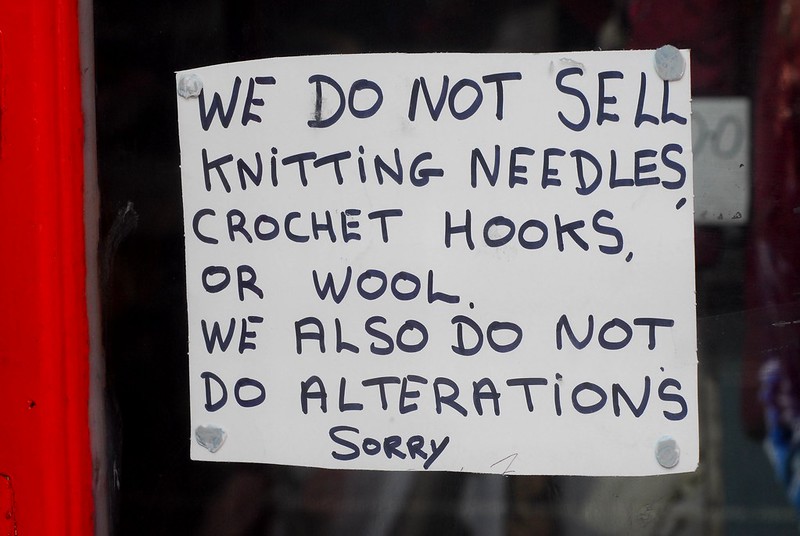It had been a while since I’d been to London. We stumbled out of bed early to get to the Zine Symposium, to give us time to get to the station and get the first London train of a Bank Holiday Sunday. The guard didn’t bother to unlock the whole train; he unlocked one door and stood by it, so he could manage the queuing passengers and let us wander along the inside to find our seats.
It didn’t take long to get there; none of the “Bank Holiday Travel Chaos!” that the media loves. We nipped across to the Bishop’s Road Underground platforms, before trundling across town to Spitalfields, where the symposium was being held. Beforehand, we explored a bit of the area, from the fashionable and gentrified Old Spitalfields Market to the more traditional junk stalls at the north end of Brick Lane. We squeezed through the Sunday market crowds, as a couple of construction workers looked down on us from atop the bare concrete of the new railway bridge there.
The Zine Symposium was, when we found it, even more crowded than the market had been, a crowd of independent-minded people squeezing between stalls and studying what was on offer. We rather liked the sound of one of the symposium talks, on the problems of running zine libraries; unfortunately, it seemed to be the weekend for promising-but-disappointing discussions. There was little on the distinctive and problematic aspects of zine libraries, like archival, conservation or cataloguing; and it was dominated by a chap called Chris from the 56a Infoshop, who had originally been planning to talk about a different topic, and largely did just that. He started with an extremely narrow-minded and prescriptive view of “zine culture” and worked from there: zines must be radical, political and ephemeral, and therefore “institutions” such as public or university libraries** should be discouraged from collecting them. This is a slightly tricky position for the curator of a zine library to hold; I was left with the impression that he only approved of libraries that he could be in charge of.
On reflection, though, there was a strong link with the class hegemony of the previous day – a stronger link than “disappointment”, I mean. Chris Of 56A disapproves strongly of anybody making money from zines, of zine-writers becoming publishers, or trying to do anything resembling a career with it. Which, essentially, is an extremely aristocratic position.*** Writing is only socially acceptable, in radical/anarchist society, if you have enough time and money to be an amateur writer, because any other approach would be a betrayal of your assumed values. It’s an interesting complement to Lapdogs of the Bourgeoisie’s “who can afford to be an art worker?” approach.
More importantly, though, Chris’s view was completely contradicted by the rest of the symposium itself, a broad range of stalls from all corners of self-publishing. Serious tracts on politics and anarchy rubbed shoulders with silly cartoons; touching memoirs next to artists’ books and prints. Much, indeed, was not too dissimilar to things we’d seen at the Bristol Artists’ Book Event a month before. I avoided the Serious Political Zines but did go for the Serious Political Vegan Cake (Lemon & Ginger Variety), which was very tasty indeed, but did in one aspect leave me slightly worried. I’m not entirely sure what the Serious Political Vegans are going to think of us submitting a dairy-heavy cake recipe to the Symposium Zine.
Full of cake, and with rather less cash on us, we escaped from the throng of zine-fans. It was a very enjoyable event, despite the politicising; and hopefully next time we go back we’ll have things to sell ourselves. We disappeared away down Brick Lane, and went off to explore some more of London.
** even somewhere like The Women’s Library, which I would have thought sufficiently radical, but which Chris specifically mentioned as being tainted by institutionality. I wondered if he had a specific gripe.
*** Compare with pre-revolutionary France, where it was perfectly acceptable for aristocrats to have craftsman-like hobbies. Louis XVI’s favourite hobby apart from hunting, for example, was locksmithing. If any aristocrats actually needed to make money from crafts or trade, though, they might suffer the penalty of dérogeance, or, being stripped of their title and status.
Keyword noise: amateurism, anarchist, Brick Lane, cake, class struggle, Lapdogs Of The Bourgeoisie, left wing, libraries, London, London Underground, London Zine Symposium, publishing, radical, self-publishing, small press, Spitalfields, travel, trustafarian, vegan, zines.


 Home
Home

